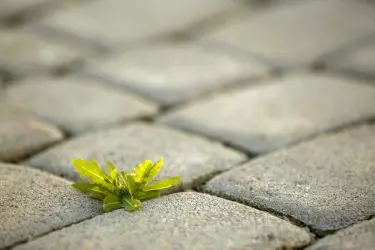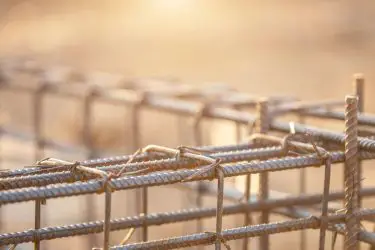As the weather gets warmer, you might be looking to spruce up the patio for the summer. There are multiple options for you to consider, but for the sake of narrowing things down, let’s stick with pavers and stamped concrete. Both patio flooring types have their pros and cons, but which is the better option for you?
The price of pavers and stamped concrete depends on what you’re getting installed. For example, a stamped driveway can cost over $11,000, and a paved driveway can average $6,000. There are also pros and cons to consider, like longevity and durability, where pavers perform better overall.
In this article, we’ll go over the advantages and disadvantages of pavers and stamped concrete. I’ll also discuss the least expensive long-term option and the differences between the two.
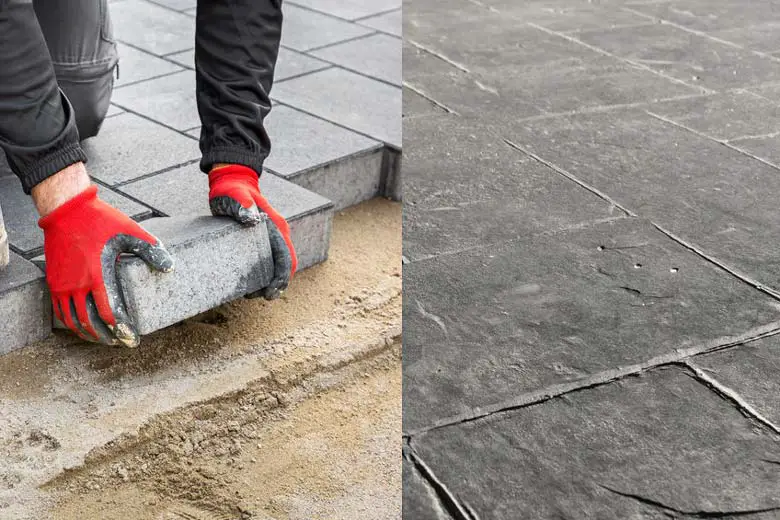
Table of Contents
Which Costs More: Pavers or Stamped Concrete?
If we were to compare every price listed, pavers and stamped concrete costs are complicated. A stamped concrete driveway and a paver driveway come out to about the same price; the concrete driveway is $11,520, and the paver driveway can total around $12,000 on the higher price end.
Paving your backyard might be around $4,000 and can turn out cheaper than a stamped concrete patio at $5,120.
If I were technical, stamped concrete would be the more expensive option because of how much you pay in upfront installation fees. Ultimately, how much you spend is dependent on what you want to be installed.
In order to determine your costs, we’ll need to explore what each has to offer, and how the pricing can vary depending on certain environmental factors at your home.
What Are Pavers?
Pavers are stone pieces that can lay in different patterns to form patios, walkways, and driveways. You can think of pavers as stone tiles most often used to make outdoor flooring.
There are two types of paver stones: the interlocking kind and concrete pavers, made from concrete molded concrete slabs and aggregate.
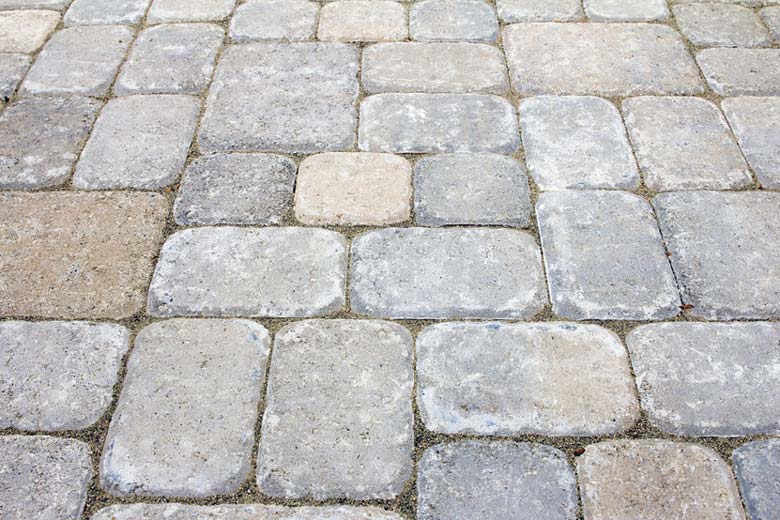
Pavers are an ancient invention; people have been using them in construction as far back as the Roman empire. There are roads made from paver stones that are still in relatively good condition today from this period.
The Dutch created the interlocking paver at the end of World War II, and many of these bricks made numerous European roads that are still traffic-worthy five decades later.
Pros of Pavers
There are many benefits to choosing pavers for your home. Not only are they versatile in their shape and design, but they are also incredibly durable. Let’s take a look at some of the key pros to consider before choosing pavers.
Pavers Offer Plenty of Design Variation
Pavers come in all sorts of colors and designs, and you can mix and match them to your specific preferences. On top of the various hues and patterns, you can get different types of stones as well.
There are pavers made from flagstone, porcelain, marble, cobblestone, and bluestone, just to name a few. Your driveway can be unique even if all your neighbors have paver stone driveways too.
Pavers Are Very Durable
Pavers can hold around 8,000 pounds (3,628.74 kg) of pressure per square inch. There is a common misconception that you can’t have a driveway made of paver stone, but keep in mind that the average car is only around 2,000 pounds (907.18 kg).
You won’t have to make repairs to your paver patio often either. Interlocking pavers are made to be flexible (they move with the ground) and are not prone to cracking or chipping.
Pavers Are Long-Lasting
On average, you can expect your pavers to last for up to 50 years. In that time, you’re not likely to need any replacements, and if they do break, repairs are easy to make. It’s not at all hard to get a hold of a replacement brick or to do the replacement yourself.
Another common misconception is that paver colors fade quickly; this is not true. The coloring is saturated throughout the entire plate, so it takes a lot for the hue to washout.
You Can Find Water-Absorbing Pavers
Some pavers are permeable, meaning they allow water to flow through the joints between the stones, preventing surface runoff.
Not only will this help to avoid soil erosion, but the soaked up water can be reused for irrigation or other purposes. This makes them an excellent option should you live in an area with lots of rainfall.
Pavers Are Excellent Pool Decking
The most annoying part of a pool (aside from cleaning it) is getting to any damaged piping or replacing the oil skimmer.
Pavers are easy to remove if need be, and they allow you easy access to any unseen pool parts that need maintenance. You’ll also have a non-slip surface around the pool, so you, your family, and your friend’s safety are assured.
Read more: Pavers vs. Concrete: Which Is Better for a Pool Deck?
You Can Find Pavers for Cheap
Pavers have this undeserved reputation for being expensive, but you can find them for dirt cheap depending on where you’re buying them.
Less expensive pavers will run you around $1.40 to $3.60 (with tax added) per square foot.
Pavers Are Weed-Proof
This list of paver pros can also be taken as a list of dispelling myths about why pavers are terrible. Many people, maybe even some of you reading this, probably think pavers automatically allow for weed growth.
Outdoors pavers use materials that disallow weeds. Instead, what you’re probably seeing are seeds that fall and grow on top of the plates.
Cons of Pavers
Here is where we’ll discuss the potential issues you may encounter with pavers. You should note that many paver problems are a matter of improper installation, rather than an issue with the products itself.
Color-Matching Different Batches Can Be Difficult
Laying pavers requires an eye for detail. Paver stones may not be the same color between pallets, so installation requires a keen eye.
Installers will need to make sure that they’re matching the colors correctly to avoid discolored spotting. This is common when working in a large area.
Issues With the Joints When Improperly Installed
Joint sand is the stuff you’d put between each plate to keep them from moving when walked or driven on top of, and it needs to be laid appropriately to prevent weeds.
Pavers can prevent weed growth, but only when the sand is applied well.
The installer should use a binding agent in conjunction with the joint sand to keep plant growth from between the stones. The binder will solidify the sand and keep weeds out.
Poor Installation Can Lead to Issues Down the Line
Poor installation can cause pavers to shift, so you’ve got to do due diligence when choosing someone to install your pavers.
Your pavers may move and sink into the ground after applying enough pressure in the aftermath of a subpar installation.
They Can Be Expensive
In general, pavers are known to be expensive. Though they can be found for cheap, the pricing is around $1 to $20 per square foot.
$20 can add up pretty quickly for larger yards; it’s crucial to research paver prices carefully if you’re looking to save money.
What Is Stamped Concrete?
Stamped concrete (also called imprinted concrete) are concrete slabs embedded with textures that mimic other building materials. For example, you could install a concrete patio with the consistency of brick if you wanted.
Stamped concrete is the prettier alternative to plain concrete and adds some panache to your yard.
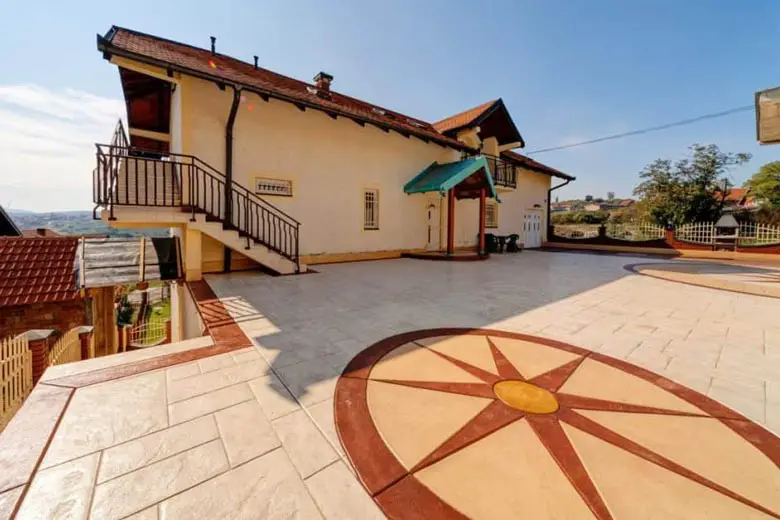
Unlike pavers, people didn’t start embossing concrete until sometime in the 1950s, although it didn’t become exceedingly popular until the 1970s. The purpose was for builders to lower construction budgets while still making their clients happy.
Concrete vs. Cement
While we’re on the subject, we should clarify the difference between concrete and cement. People use both terms interchangeably, but cement and concrete aren’t quite the same things.
Cement is a binder, and typically used in a mix to help it harden and set. Cement is usually combined with water, sand, and gravel to make concrete.
Pros of Stamped Concrete
From its versatility and customizability to its weather-proof finish (if sealed), stamped concrete is robust and typically the cheapest option. Similar to the above section, let’s take a look at the benefits provided by choosing stamped concrete.
Wide Variety of Designs
Stamped concrete can be textured in a wide variety of styles to look like almost anything. You can get your concrete to resemble wood, slate, brick, flagstone, tile, and many other patterns and textures.
Just take a look at this 11 Good-Looking Stamp Patterns for Concrete Work!
Purchasing concrete that mimics different building materials is generally cheaper than buying materials like stone or brick.
Easy To Customize
One of the best aspects of stamped concrete is how customizable it is. Installers can press any pattern you want into the material and contractors can mix colors on-site because concrete is easy to transport. You’re able to see the entire design process happen in front of you.
Weather-Proof
Stamped concrete is easy to protect from the weather. Anything can be damaged when exposed to the weather or harsh chemicals and with that in mind, you should have your concrete sealed to prevent damages from water or freezing.
The sealant will protect your stamped concrete from pool chemicals and oil spills, or other automobile leakages.
Stamped Concrete Is Long-Lasting
Generally speaking, concrete lasts a long time, with the typical life expectancy of stamped concrete being 25 years.
With proper maintenance, you can expect your concrete patio or walkway to last for over two decades – especially if you apply a weather-proof sealant.
The Cheaper Option
Stamped concrete can be cheaper than pavers due to the ease of which it is mixed and installed. The cost of pavers per square foot can reach as much as $20.
On the other hand, stamped concrete can be as cheap as $8 and run as much as $18 per square foot.
Slip-Resistant
Many people use stamped concrete for decking around pools because it can be made slip-resistant with a non-skid treatment. This is typically done by adding texture to the final finish, giving the surface a slip-proof feel.
Cons of Stamped Concrete
Again, as with any pros, there are inevitable cons involved too. Here I’ll go over some of the cons you might expect from choosing stamped concrete.
Not as Durable
Stamped concrete isn’t as durable as pavers and there’s already a significant disparity in how long stamped concrete lasts compared to pavers. Pavers can last for up to 50 years, while concrete is usually good for only 25 years.
Concrete is also prone to cracking over time since it doesn’t have the flexibility of pavers.
Not Easy To Remove
Serious repair and getting to underground pipes can be complicated. Small cracks can be hidden or fixed with a simple DIY patch job, whereas larger gaps can take more labor-intensive, professional work to repair.
It’s not easy to get to any underground piping from concrete either. Fixing a busted pipe may require drilling to remove the material from on top of it.
Not for DIY
Anyone reading this could install pavers if they have the time and a willingness to follow instructions. While I’m sure that some people reading this have the skills to lay concrete on their own, most people will have to rely on professionals to do the job for them properly.
Stamped Concrete Is Not Flexible
Earthquakes and foundation issues can damage concrete as it isn’t flexible like interlocking pavers. This means that the material can’t move in the event of earthquakes and the lacking malleability ends up fracturing the concrete.
Stamped concrete’s inflexibility means that pressure from unstable foundations can cause cracking too.
The Patterns Might Not Last
Unfortunately, deicing salt can wreck patterns stamped into your concrete. If you live in a cold climate, chances are you use such a product yearly – possible multiple times per year. The coarseness of the salt can cause ornate patterns and designs to erode after time.
Higher Upfront Cost
Concrete costs less than pavers per square foot but has higher upfront costs. Stamped concrete can require a lot of prep work, and you could end up paying around the same or more as you would for installing pavers. In addition, you will likely need to pay to have the concrete resealed frequently.
Also read: Should Concrete Pavers Be Sealed?
Pavers vs. Stamped Concrete: Which Is Cheaper?
It is possible to find cheap pavers. You’ll have to do a bit of shopping around, but it is possible. In general, though, concrete is an inexpensive material.
Still, comparing the cost of laying pavers vs. stamped concrete is a bit complicated. How much you pay depends on factors like the type of pavers you want and where you’re getting the stamped concrete installed.

Paver Costs
The typical homeowner can expect to pay approximately $2 to $4 on average for every square foot for pavers. This estimate does vary, though, depending on the kind of paver material chosen, style, and texture. Brick pavers, for example, cost $2 to $8 per square foot.
How much you pay for installation differs from paver type to type too. If I continue with our brick paver example, installation costs would usually range from $10 to $17 per square foot.
You’ll have to consider expenses for different finishes too. A polished look will cost around three more cents, and engraved pavers will run an additional $46.55.
Below we’ll discuss the different paver costs per square foot and their installation costs. We’ll finish off this section by going over the total amount you’d pay for a paver walkway, driveway, or patio.
Stone Pavers
Stone pavers are on the less expensive end of the price spectrum and average around $1 to $3 per square foot. The installation costs are somewhere about $8 and $14 per square foot. Natural stone pavers include cobblestone, granite, travertine, marble, and flagstone.
Porcelain Pavers
If you want porcelain pavers, be prepared to shell out $5 to $10 per square foot. Any installer you hire may charge somewhere from $12 to $20 per square foot to lay.
Porcelain is perfect for locations with high foot traffic due to its durability and slip-resistant coating. Porcelain pavers can withstand the harsh deicing chemicals in cold weather too.
Slate Pavers
Anyone wanting slate can expect an average payment of $5 to $10 per square foot, and installation fees start from $15 and reach as much as $20. Slate pavers tend to be on the larger side and have a non-slip texture that makes them great for wet areas like rainy regions and pools.
Plastic Pavers
I wouldn’t advise plastic unless you’re only looking to enhance your home’s curb appeal. Plastic pavers aren’t solid – they’re void on the inside and won’t stand up well against heavy foot traffic. Contractors can install plastic quickly enough on soft soil, but it’s more challenging to do on more solid ground.
Interlocking Pavers
Interlocking pavers cost an average of $2 to $8 per square foot.
Interlocking paver plates are perhaps the easiest to install, come pre-sealed, and don’t need regular maintenance.
While paver longevity averages 50 years among the different materials, interlocking blocks can last upwards of 30 years.
Paver Cost per Project
The nice thing about pavers is that they can be arranged in whatever fashion you choose. Usually, projects (patios, walkways, driveways, and pool decking) will set a homeowner back $10 to $25 per square foot.
Installation prices will fluctuate according to what you want, but generally, you can expect prices to start from the low-end of $900 to the more expensive $20,000.
The pricing per paver project is as follows:
- Walkways: $900 to $2,000
- Backyard: $1,000 to $4,000
- Patios: $1,900 to $4,900
- Driveway: $5,500 to $12,000
- Pool decking: $5,000 to $20,000
Stamped Concrete Costs
The pricing for stamped concrete is a combination of labor costs and fees for decorative additions. Specific concrete jobs will require the contractors to grade or even out the dirt.
Grading involves shifting or removing some of the soil you’re pouring the concrete on. Grading soil can cost you $50 to $70 per hour. A subbase – a layer of sand or gravel – might have to be placed before contractors can pour concrete, and this can run a homeowner $12 to $18 per cubic yard.
You might also have to add steel rebar to concrete driveways for stabilization and durability; cars are heavy, after all. Most of what I’ve shared just now is only the costs involved with laying plain concrete.
You’ll have to pay $8 to $12 per square foot for stamped concrete; this, of course, is just a general price.
Higher-end stamped concrete sometimes runs over $18 per square foot.
Having the concrete stained may be $2 to $4 per square foot with more straightforward jobs, but more extensive staining (mixing colors and ornate designs) can be more than $15 per square foot.
Read more: Cost of Acid Staining a Concrete Floor: What you need to know
Stamped Concrete Cost per Project
Stamped concrete patios, driveways, and walkways will differ in price depending on how much detail you want in the design.
The cost of a stamped concrete walkway, for example, can fluctuate due to how many square feet you want to pour. A walkway’s surface area can vary wildly, so estimating pricing is no simple task.
- Stamped concrete patios: Anywhere from $5,120 to $11,520.
- Stamped concrete walkways: Around $6 to $12 per square foot.
- Stamped concrete driveway: On average $5,120 to $11,520.
Of course, each of these will differ should you choose a more extraordinary pattern, color, or if the area is abnormally large.
Which Is Easier To Maintain: Pavers or Stamped Concrete?
Stamped concrete and pavers are both easy to maintain and keep clean; the problems arise when it comes to repairs. Pavers are – for the most part – more durable and can take more damage overall.
Concrete, on the other hand, can crack and split as it gets older and more worn. The more time that passes, the more likely it is that you’ll need to replace the entire damaged section. The cost of repairing concrete can be $8 to more than $500, depending on the level of damage and labor costs.
You can patch cracked sections after a while, but the constant repairs will begin to look off and discolored.
Paver stones likely won’t need such extensive repairs. The paver joints will need cleaning and resealing occasionally, but you can replace damaged plates with ease. If you’re unsure how to maintain the joints or replace pavers, hire a professional to handle it for you.
Also Read: 10 Best Ways To Clean Concrete Pavers
Which Adds More Value to Your Home?
Adding extra bits of curb appeal can increase the value of your home significantly. Firepits, outdoor kitchens, decks; anything you can utilize or makes your home look better can increase your home’s worth.
Homeowners often use concrete as pavement, so the ROI (return on investment) won’t be much, even if it’s stamped. A house’s ROI is the way you’d measure how much of a return you’d get from investment (like pavers, in this case).
Pavers can add an incredible amount of market value to your home. If they’re well-installed and match the decor of your home, you can expect an ROI that’s at up to 75% of the cost you originally paid.
A lovely paver patio can add up to $15,000 to your house’s selling price. A home can sell faster if you’ve got a patio because it’s something many buyers want.
The size of your property, location, and what you do with the pavers can impact your home’s added dollar amount. A patio could add $15,000 to your house’s price, but using pavers to a garden patio can increase your home’s value by even more.
Can Pavers or Stamped Concrete Be Used Indoors?
It may not come as news to many of you reading this, but concrete interior flooring isn’t new. Stamped concrete is a viable choice as inside flooring too. If you’re tired of wood or carpet floors, stamped cement is a refreshing choice.
You can have the cement stained with whatever color you want and sealed to prevent damage. The design and pattern can be whatever you’re willing to pay for.
You can choose from two kinds of concrete floors – existing and decorative. You can modify existing concrete floors with stains, polish, and decorative overlays are installed on top of preexisting hard floors for a new look.
Stamped concrete is a good flooring alternative for homeowners that are looking to go green too. Concrete doesn’t reduce natural resources, and it’s mold, mildew, and odor-proof.
Stamped concrete flooring is a good fit for rooms like kitchens, bathrooms, and basements because it can be made slip-proof, stain-proof, and is easy to keep clean.
The hard, easy-to-clean surface makes stamped concrete ideal for pets. Cats and dogs’ claws can’t damage concrete very easily, and removing pet hair or messes is simple.
What may come as a surprise to some readers is that pavers can also be used as interior flooring.
There is a difference between indoors and outdoors pavers, though. Interior pavers are thinner, and your choices should be limited to brick, natural stone, and cement. Pavers used for outdoor purposes are thicker and would be harder to use inside.
You must choose the right paver for the proper room. Pavers placed in the bathroom, laundry room, and kitchen should be slip-resistant and have enough traction to prevent falls. Kitchen pavers should be stain-resistant, and pavers throughout hallways and entries should be easy to clean.
The only room where pavers might be a bad idea is the bedrooms. Pavers don’t exactly retain heat, so they can be uncomfortable to touch in cold weather. Rooms that connect to the outdoors are the best places for paver tiles.
Conclusion
When comparing pavers and stamped concrete each have their pros and cons, but pavers are overall the best choice. Stamped concrete has higher upfront costs due to labor costs and is often the more expensive project. There are times, though, where paver projects can cost more – high-end paver driveways can be more costly than stamped concrete driveways, for example.
Typically, projects built with either material cost around the same amount, but pavers can add more value to your home. Which material you pick is best left to personal preference.

